实例介绍
【实例截图】


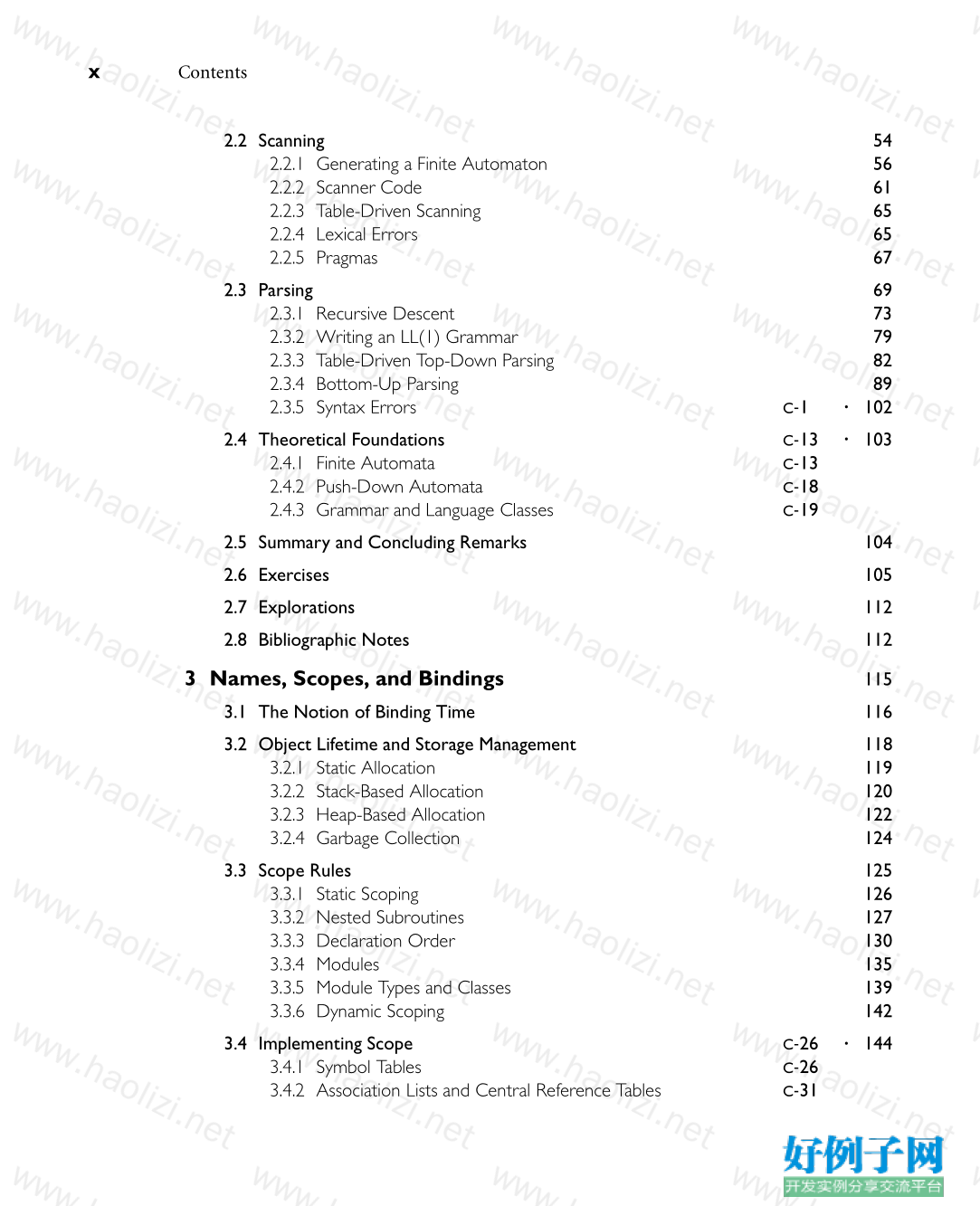
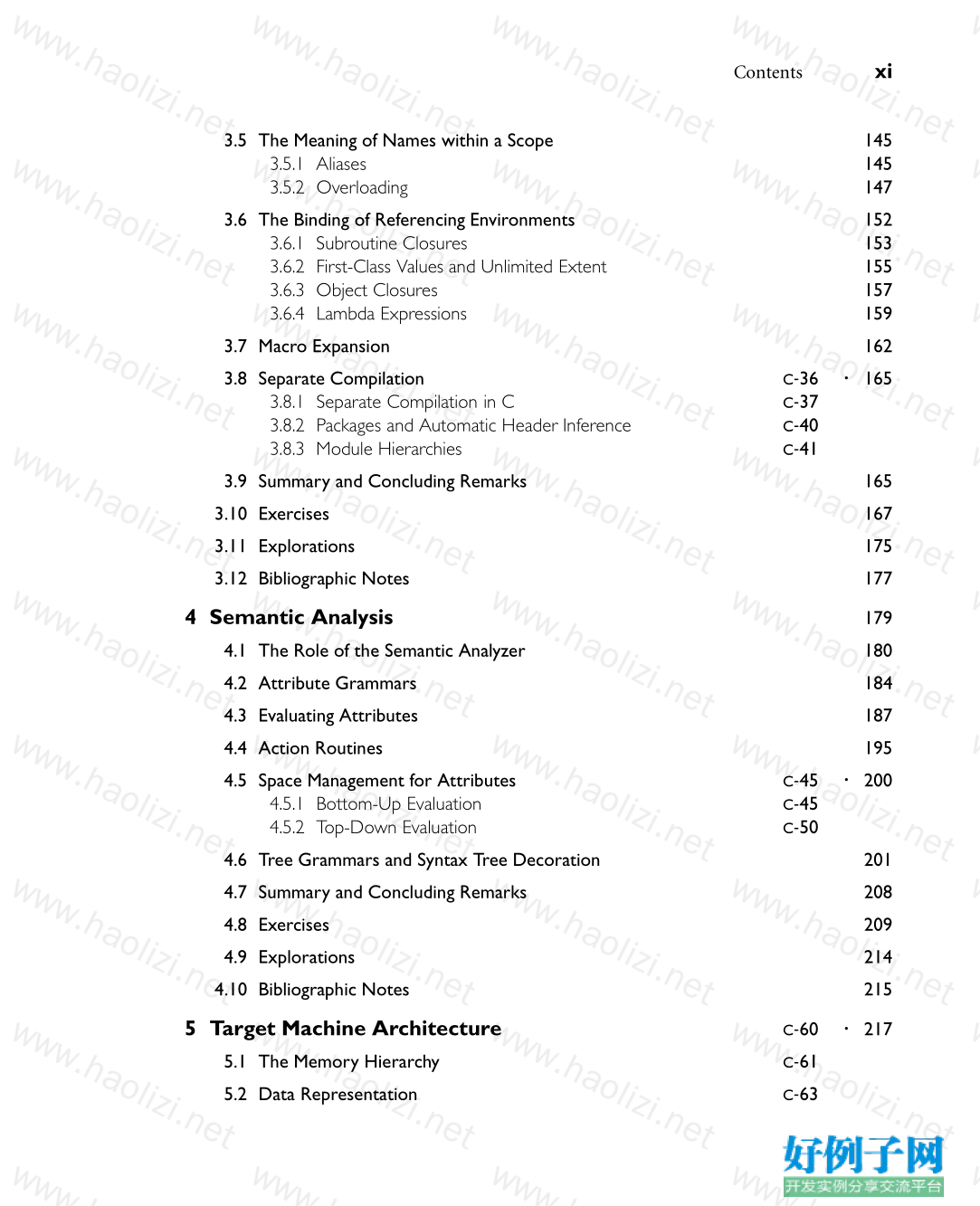
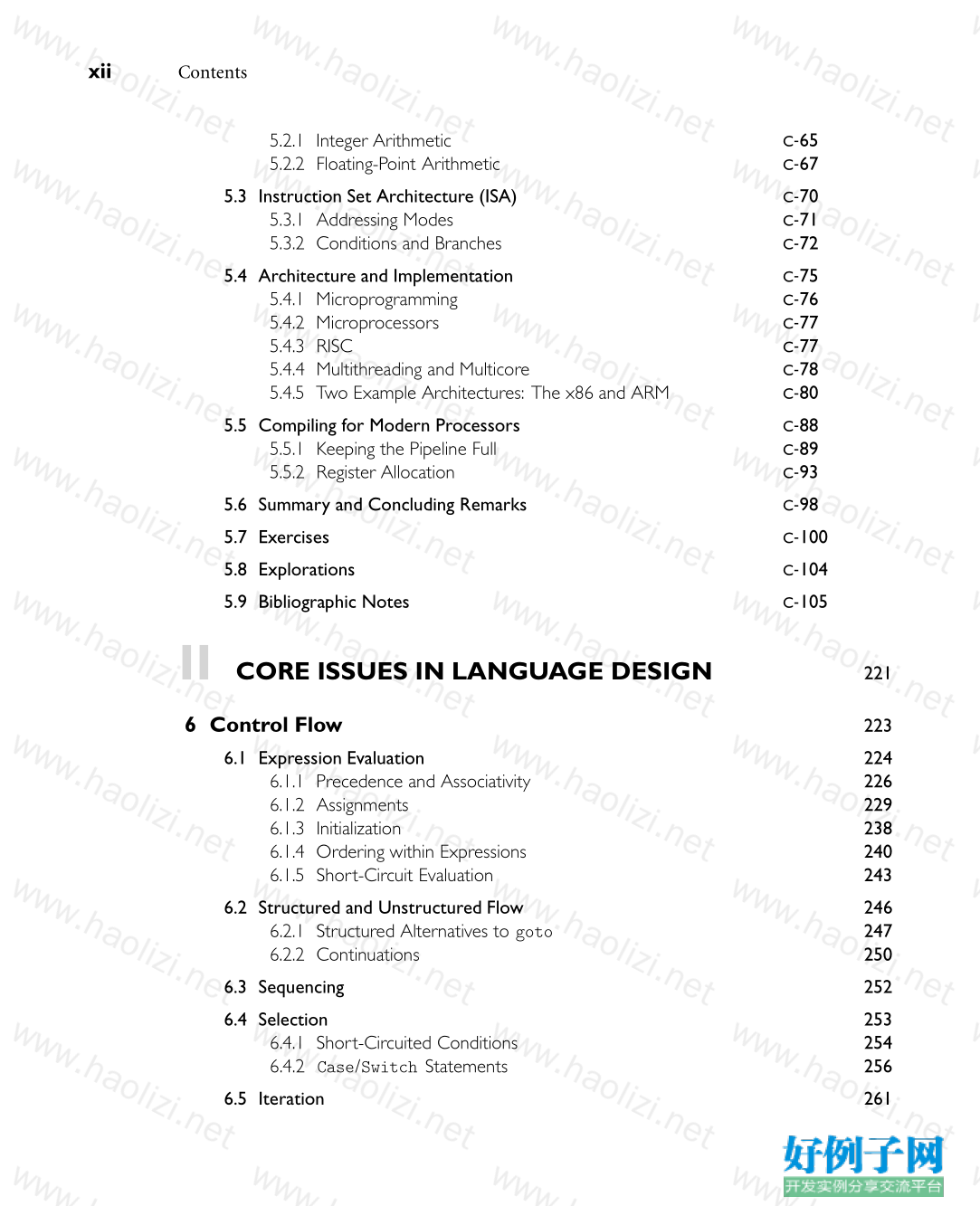
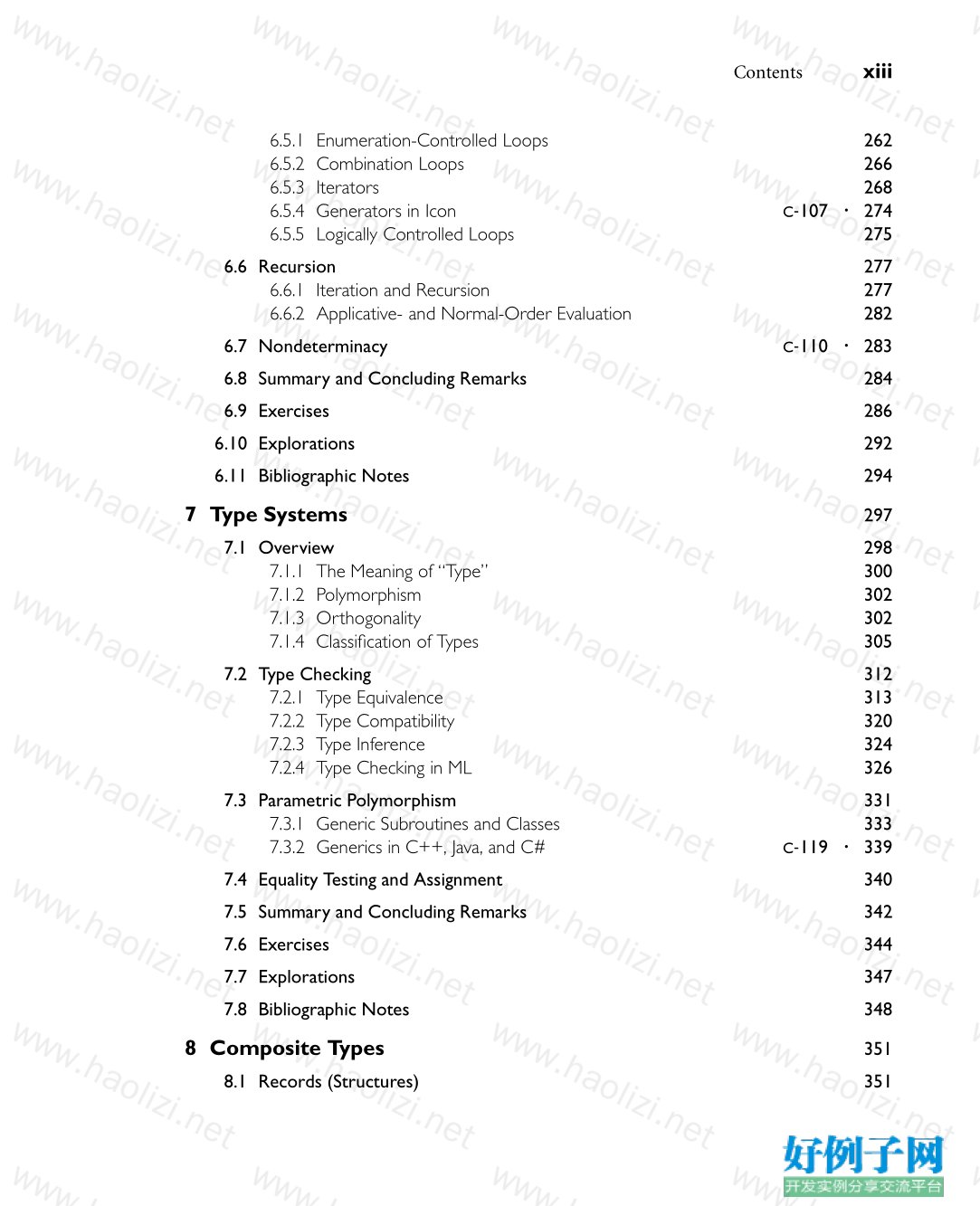

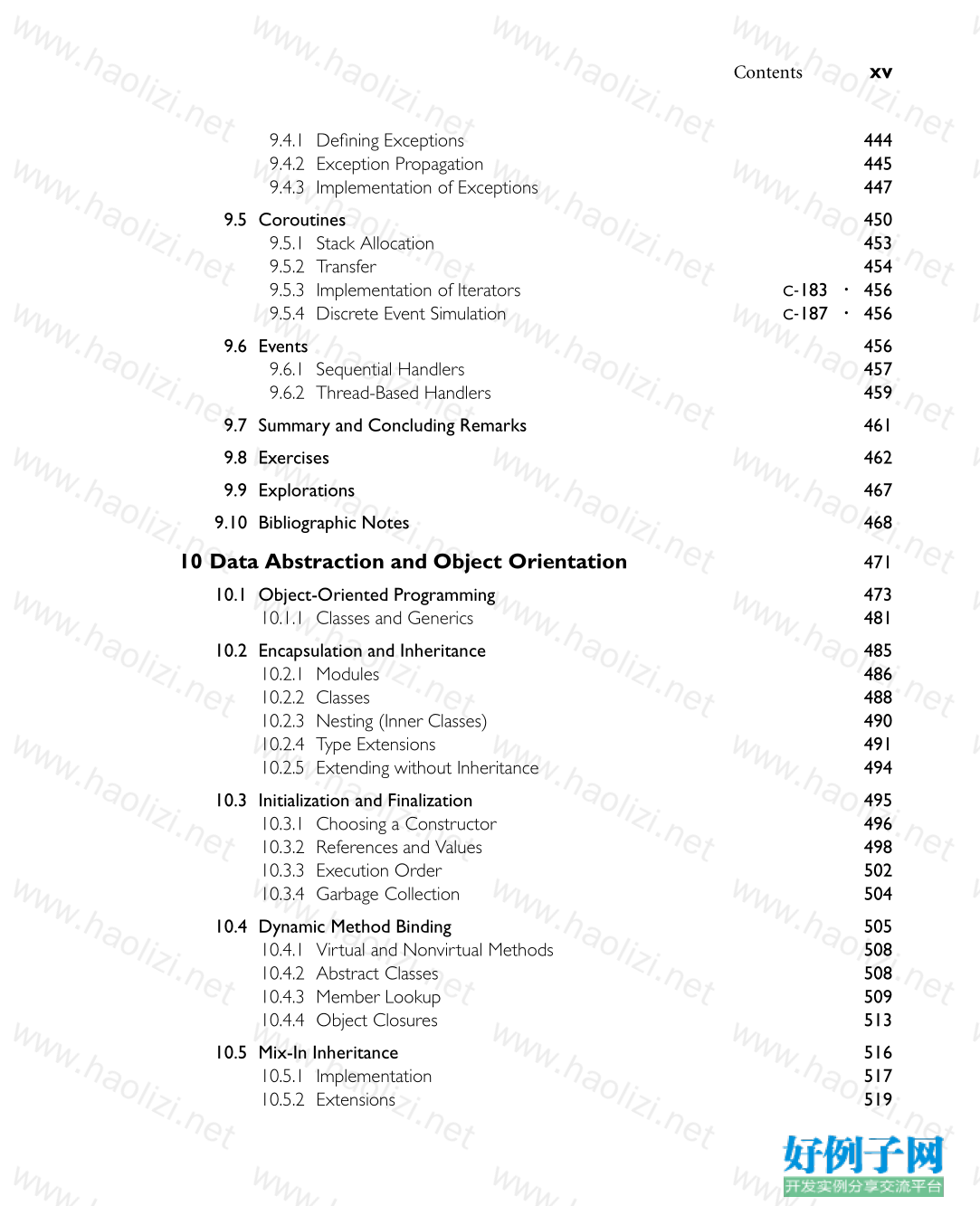
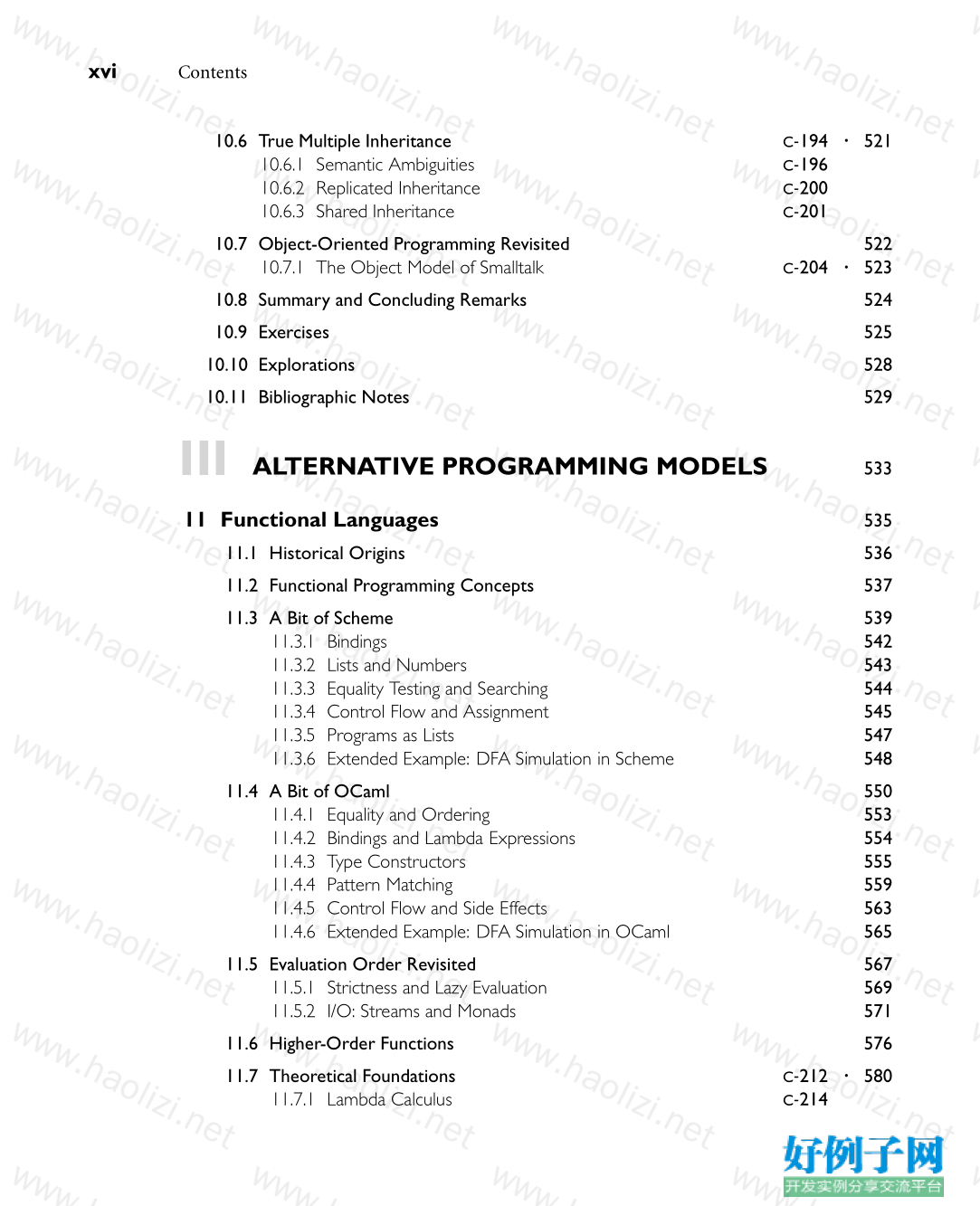


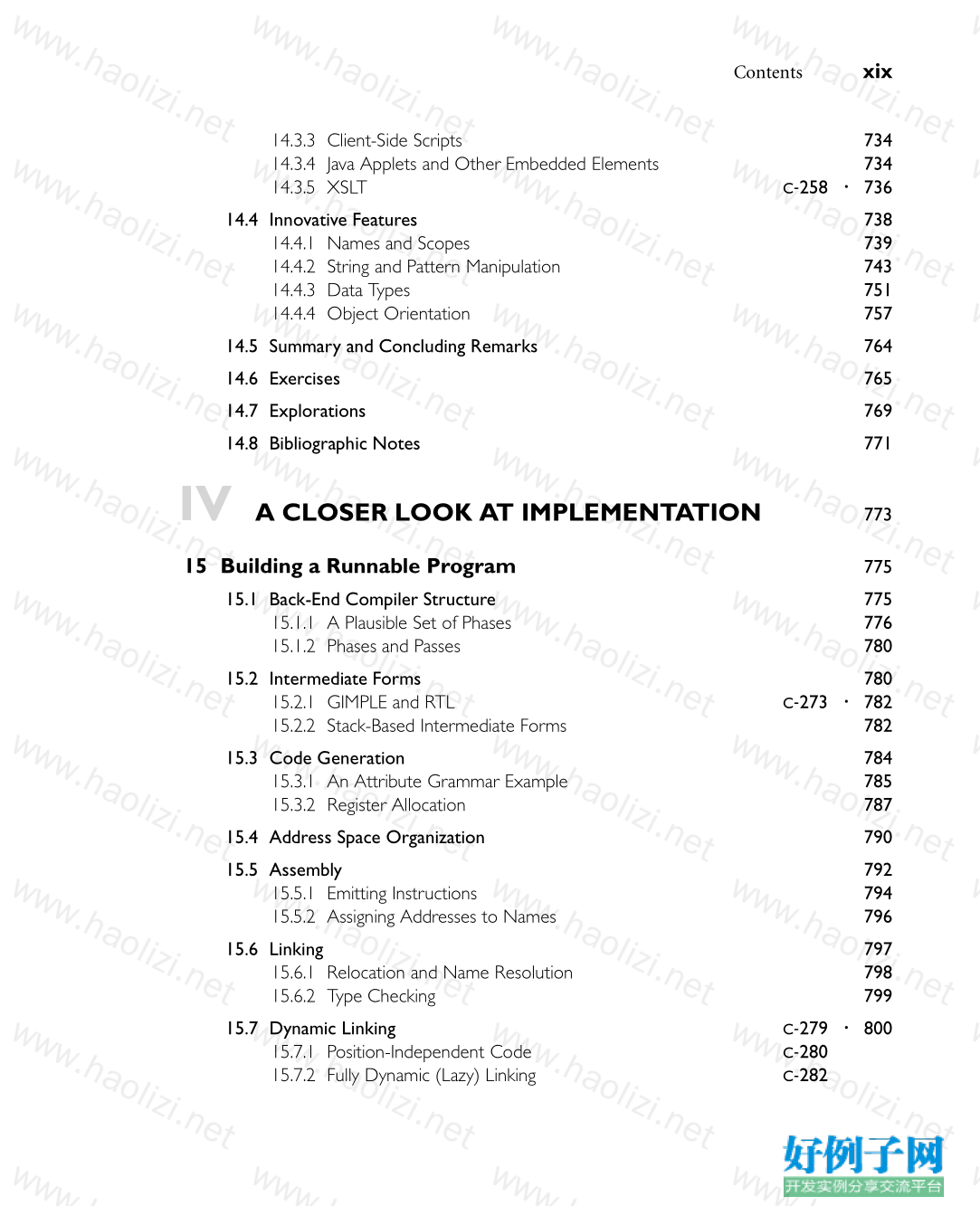
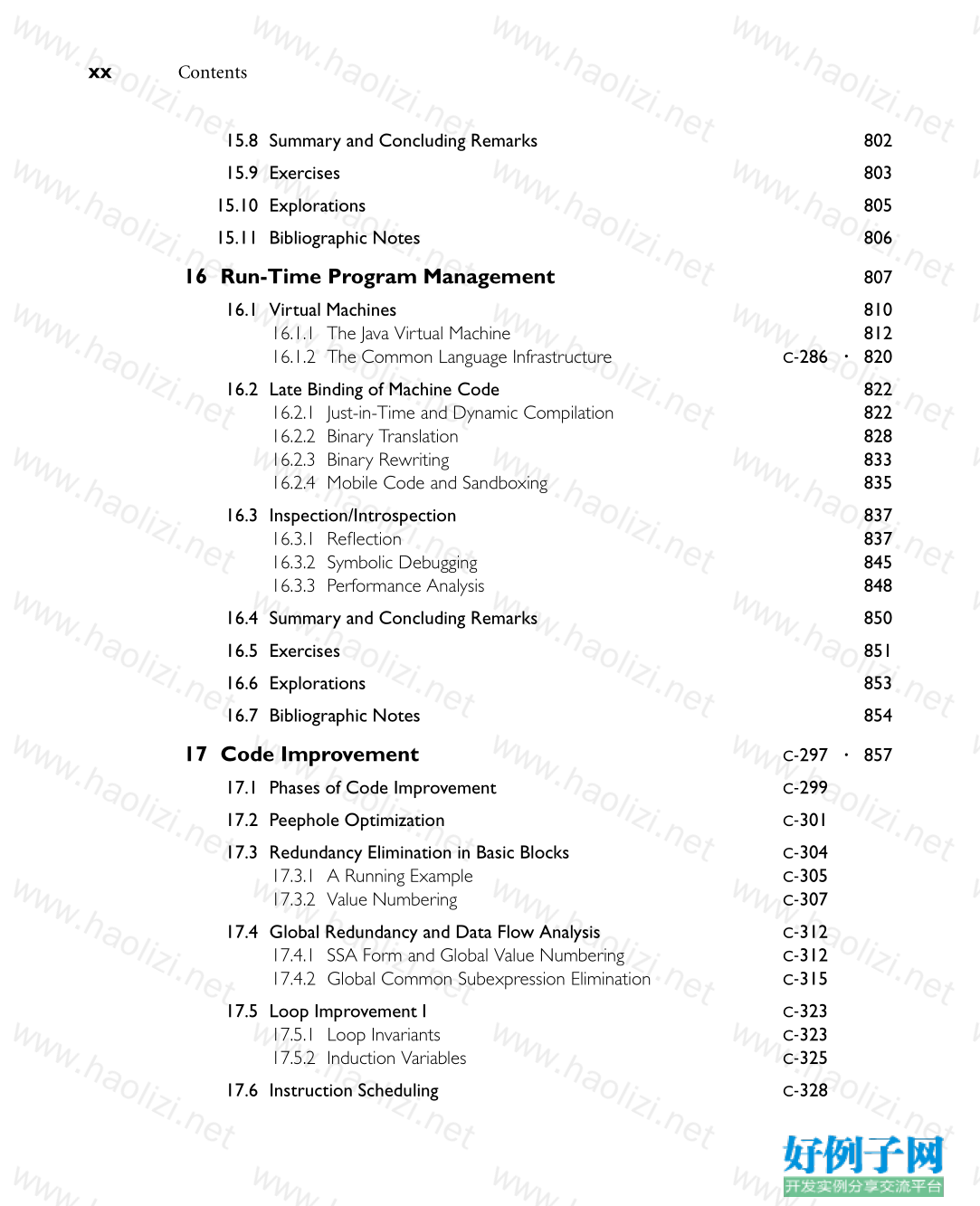
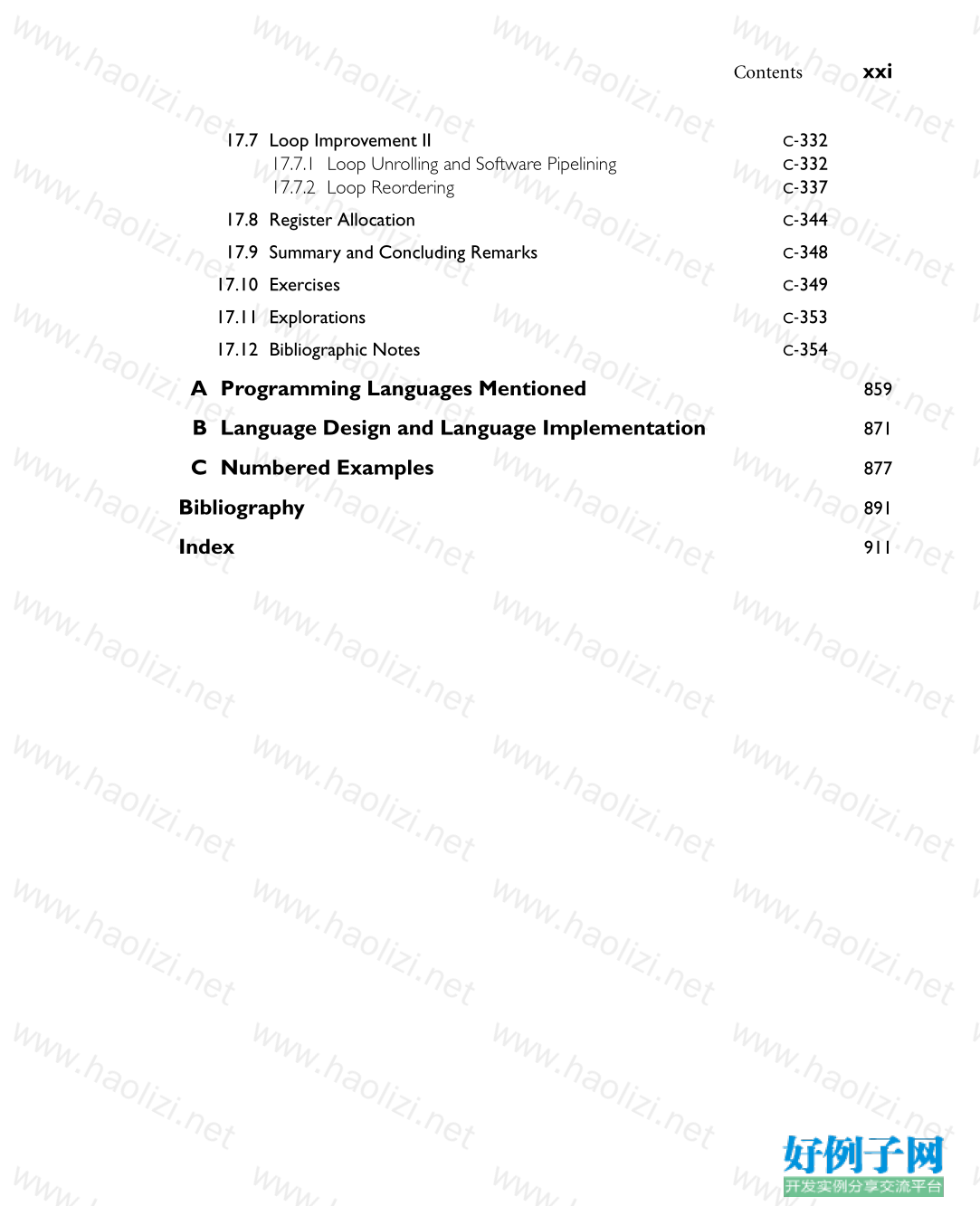
【核心代码】
Contents
Foreword xxiii
Preface xxv
I FOUNDATIONS 3
1 Introduction 5
1.1 The Art of Language Design 7
1.2 The Programming Language Spectrum 11
1.3 Why Study Programming Languages? 14
1.4 Compilation and Interpretation 17
1.5 Programming Environments 24
1.6 An Overview of Compilation 26
1.6.1 Lexical and Syntax Analysis 28
1.6.2 Semantic Analysis and Intermediate Code Generation 32
1.6.3 Target Code Generation 34
1.6.4 Code Improvement 36
1.7 Summary and Concluding Remarks 37
1.8 Exercises 38
1.9 Explorations 39
1.10 Bibliographic Notes 40
2 Programming Language Syntax 43
2.1 Specifying Syntax: Regular Expressions and Context-Free Grammars 44
2.1.1 Tokens and Regular Expressions 45
2.1.2 Context-Free Grammars 48
2.1.3 Derivations and Parse Trees 50
x Contents
2.2 Scanning 54
2.2.1 Generating a Finite Automaton 56
2.2.2 Scanner Code 61
2.2.3 Table-Driven Scanning 65
2.2.4 Lexical Errors 65
2.2.5 Pragmas 67
2.3 Parsing 69
2.3.1 Recursive Descent 73
2.3.2 Writing an LL(1) Grammar 79
2.3.3 Table-Driven Top-Down Parsing 82
2.3.4 Bottom-Up Parsing 89
2.3.5 Syntax Errors C 1
.
102
2.4 Theoretical Foundations C 13
.
103
2.4.1 Finite Automata C 13
2.4.2 Push-Down Automata C 18
2.4.3 Grammar and Language Classes C 19
2.5 Summary and Concluding Remarks 104
2.6 Exercises 105
2.7 Explorations 112
2.8 Bibliographic Notes 112
3 Names, Scopes, and Bindings 115
3.1 The Notion of Binding Time 116
3.2 Object Lifetime and Storage Management 118
3.2.1 Static Allocation 119
3.2.2 Stack-Based Allocation 120
3.2.3 Heap-Based Allocation 122
3.2.4 Garbage Collection 124
3.3 Scope Rules 125
3.3.1 Static Scoping 126
3.3.2 Nested Subroutines 127
3.3.3 Declaration Order 130
3.3.4 Modules 135
3.3.5 Module Types and Classes 139
3.3.6 Dynamic Scoping 142
3.4 Implementing Scope C 26
.
144
3.4.1 Symbol Tables C 26
3.4.2 Association Lists and Central Reference Tables C 31
Contents xi
3.5 The Meaning of Names within a Scope 145
3.5.1 Aliases 145
3.5.2 Overloading 147
3.6 The Binding of Referencing Environments 152
3.6.1 Subroutine Closures 153
3.6.2 First-Class Values and Unlimited Extent 155
3.6.3 Object Closures 157
3.6.4 Lambda Expressions 159
3.7 Macro Expansion 162
3.8 Separate Compilation C 36
.
165
3.8.1 Separate Compilation in C C 37
3.8.2 Packages and Automatic Header Inference C 40
3.8.3 Module Hierarchies C 41
3.9 Summary and Concluding Remarks 165
3.10 Exercises 167
3.11 Explorations 175
3.12 Bibliographic Notes 177
4 Semantic Analysis 179
4.1 The Role of the Semantic Analyzer 180
4.2 Attribute Grammars 184
4.3 Evaluating Attributes 187
4.4 Action Routines 195
4.5 Space Management for Attributes C 45
.
200
4.5.1 Bottom-Up Evaluation C 45
4.5.2 Top-Down Evaluation C 50
4.6 Tree Grammars and Syntax Tree Decoration 201
4.7 Summary and Concluding Remarks 208
4.8 Exercises 209
4.9 Explorations 214
4.10 Bibliographic Notes 215
5 Target Machine Architecture C 60
.
217
5.1 The Memory Hierarchy C 61
5.2 Data Representation C 63
xii Contents
5.2.1 Integer Arithmetic C 65
5.2.2 Floating-Point Arithmetic C 67
5.3 Instruction Set Architecture (ISA) C 70
5.3.1 Addressing Modes C 71
5.3.2 Conditions and Branches C 72
5.4 Architecture and Implementation C 75
5.4.1 Microprogramming C 76
5.4.2 Microprocessors C 77
5.4.3 RISC C 77
5.4.4 Multithreading and Multicore C 78
5.4.5 Two Example Architectures: The x86 and ARM C 80
5.5 Compiling for Modern Processors C 88
5.5.1 Keeping the Pipeline Full C 89
5.5.2 Register Allocation C 93
5.6 Summary and Concluding Remarks C 98
5.7 Exercises C 100
5.8 Explorations C 104
5.9 Bibliographic Notes C 105
II CORE ISSUES IN LANGUAGE DESIGN 221
6 Control Flow 223
6.1 Expression Evaluation 224
6.1.1 Precedence and Associativity 226
6.1.2 Assignments 229
6.1.3 Initialization 238
6.1.4 Ordering within Expressions 240
6.1.5 Short-Circuit Evaluation 243
6.2 Structured and Unstructured Flow 246
6.2.1 Structured Alternatives to goto 247
6.2.2 Continuations 250
6.3 Sequencing 252
6.4 Selection 253
6.4.1 Short-Circuited Conditions 254
6.4.2 Case / Switch Statements 256
6.5 Iteration 261
Contents xiii
6.5.1 Enumeration-Controlled Loops 262
6.5.2 Combination Loops 266
6.5.3 Iterators 268
6.5.4 Generators in Icon C 107
.
274
6.5.5 Logically Controlled Loops 275
6.6 Recursion 277
6.6.1 Iteration and Recursion 277
6.6.2 Applicative- and Normal-Order Evaluation 282
6.7 Nondeterminacy C 110
.
283
6.8 Summary and Concluding Remarks 284
6.9 Exercises 286
6.10 Explorations 292
6.11 Bibliographic Notes 294
7 Type Systems 297
7.1 Overview 298
7.1.1 The Meaning of “Type” 300
7.1.2 Polymorphism 302
7.1.3 Orthogonality 302
7.1.4 Classification of Types 305
7.2 Type Checking 312
7.2.1 Type Equivalence 313
7.2.2 Type Compatibility 320
7.2.3 Type Inference 324
7.2.4 Type Checking in ML 326
7.3 Parametric Polymorphism 331
7.3.1 Generic Subroutines and Classes 333
7.3.2 Generics in C , Java, and C# C 119
.
339
7.4 Equality Testing and Assignment 340
7.5 Summary and Concluding Remarks 342
7.6 Exercises 344
7.7 Explorations 347
7.8 Bibliographic Notes 348
8 Composite Types 351
8.1 Records (Structures) 351
xiv Contents
8.1.1 Syntax and Operations 352
8.1.2 Memory Layout and Its Impact 353
8.1.3 Variant Records (Unions) C 136
.
357
8.2 Arrays 359
8.2.1 Syntax and Operations 359
8.2.2 Dimensions, Bounds, and Allocation 363
8.2.3 Memory Layout 368
8.3 Strings 375
8.4 Sets 376
8.5 Pointers and Recursive Types 377
8.5.1 Syntax and Operations 378
8.5.2 Dangling References C 144
.
388
8.5.3 Garbage Collection 389
8.6 Lists 398
8.7 Files and Input/Output C 148
.
401
8.7.1 Interactive I/O C 148
8.7.2 File-Based I/O C 149
8.7.3 Text I/O C 151
8.8 Summary and Concluding Remarks 402
8.9 Exercises 404
8.10 Explorations 409
8.11 Bibliographic Notes 410
9 Subroutines and Control Abstraction 411
9.1 Review of Stack Layout 412
9.2 Calling Sequences 414
9.2.1 Displays C 163
.
417
9.2.2 Stack Case Studies: LLVM on ARM; gcc on x86 C 167
.
417
9.2.3 Register Windows C 177
.
419
9.2.4 In-Line Expansion 419
9.3 Parameter Passing 422
9.3.1 Parameter Modes 423
9.3.2 Call by Name C 180
.
433
9.3.3 Special-Purpose Parameters 433
9.3.4 Function Returns 438
9.4 Exception Handling 440
Contents xv
9.4.1 Defining Exceptions 444
9.4.2 Exception Propagation 445
9.4.3 Implementation of Exceptions 447
9.5 Coroutines 450
9.5.1 Stack Allocation 453
9.5.2 Transfer 454
9.5.3 Implementation of Iterators C 183
.
456
9.5.4 Discrete Event Simulation C 187
.
456
9.6 Events 456
9.6.1 Sequential Handlers 457
9.6.2 Thread-Based Handlers 459
9.7 Summary and Concluding Remarks 461
9.8 Exercises 462
9.9 Explorations 467
9.10 Bibliographic Notes 468
10 Data Abstraction and Object Orientation 471
10.1 Object-Oriented Programming 473
10.1.1 Classes and Generics 481
10.2 Encapsulation and Inheritance 485
10.2.1 Modules 486
10.2.2 Classes 488
10.2.3 Nesting (Inner Classes) 490
10.2.4 Type Extensions 491
10.2.5 Extending without Inheritance 494
10.3 Initialization and Finalization 495
10.3.1 Choosing a Constructor 496
10.3.2 References and Values 498
10.3.3 Execution Order 502
10.3.4 Garbage Collection 504
10.4 Dynamic Method Binding 505
10.4.1 Virtual and Nonvirtual Methods 508
10.4.2 Abstract Classes 508
10.4.3 Member Lookup 509
10.4.4 Object Closures 513
10.5 Mix-In Inheritance 516
10.5.1 Implementation 517
10.5.2 Extensions 519
xvi Contents
10.6 True Multiple Inheritance C 194
.
521
10.6.1 Semantic Ambiguities C 196
10.6.2 Replicated Inheritance C 200
10.6.3 Shared Inheritance C 201
10.7 Object-Oriented Programming Revisited 522
10.7.1 The Object Model of Smalltalk C 204
.
523
10.8 Summary and Concluding Remarks 524
10.9 Exercises 525
10.10 Explorations 528
10.11 Bibliographic Notes 529
III ALTERNATIVE PROGRAMMING MODELS 533
11 Functional Languages 535
11.1 Historical Origins 536
11.2 Functional Programming Concepts 537
11.3 A Bit of Scheme 539
11.3.1 Bindings 542
11.3.2 Lists and Numbers 543
11.3.3 Equality Testing and Searching 544
11.3.4 Control Flow and Assignment 545
11.3.5 Programs as Lists 547
11.3.6 Extended Example: DFA Simulation in Scheme 548
11.4 A Bit of OCaml 550
11.4.1 Equality and Ordering 553
11.4.2 Bindings and Lambda Expressions 554
11.4.3 Type Constructors 555
11.4.4 Pattern Matching 559
11.4.5 Control Flow and Side Effects 563
11.4.6 Extended Example: DFA Simulation in OCaml 565
11.5 Evaluation Order Revisited 567
11.5.1 Strictness and Lazy Evaluation 569
11.5.2 I/O: Streams and Monads 571
11.6 Higher-Order Functions 576
11.7 Theoretical Foundations C 212
.
580
11.7.1 Lambda Calculus C 214
Contents xvii
11.7.2 Control Flow C 217
11.7.3 Structures C 219
11.8 Functional Programming in Perspective 581
11.9 Summary and Concluding Remarks 583
11.10 Exercises 584
11.11 Explorations 589
11.12 Bibliographic Notes 590
12 Logic Languages 591
12.1 Logic Programming Concepts 592
12.2 Prolog 593
12.2.1 Resolution and Unification 595
12.2.2 Lists 596
12.2.3 Arithmetic 597
12.2.4 Search/Execution Order 598
12.2.5 Extended Example: Tic-Tac-Toe 600
12.2.6 Imperative Control Flow 604
12.2.7 Database Manipulation 607
12.3 Theoretical Foundations C 226
.
612
12.3.1 Clausal Form C 227
12.3.2 Limitations C 228
12.3.3 Skolemization C 230
12.4 Logic Programming in Perspective 613
12.4.1 Parts of Logic Not Covered 613
12.4.2 Execution Order 613
12.4.3 Negation and the “Closed World” Assumption 615
12.5 Summary and Concluding Remarks 616
12.6 Exercises 618
12.7 Explorations 620
12.8 Bibliographic Notes 620
13 Concurrency 623
13.1 Background and Motivation 624
13.1.1 The Case for Multithreaded Programs 627
13.1.2 Multiprocessor Architecture 631
13.2 Concurrent Programming Fundamentals 635
xviii Contents
13.2.1 Communication and Synchronization 635
13.2.2 Languages and Libraries 637
13.2.3 Thread Creation Syntax 638
13.2.4 Implementation of Threads 647
13.3 Implementing Synchronization 652
13.3.1 Busy-Wait Synchronization 653
13.3.2 Nonblocking Algorithms 657
13.3.3 Memory Consistency 659
13.3.4 Scheduler Implementation 663
13.3.5 Semaphores 667
13.4 Language-Level Constructs 669
13.4.1 Monitors 669
13.4.2 Conditional Critical Regions 674
13.4.3 Synchronization in Java 676
13.4.4 Transactional Memory 679
13.4.5 Implicit Synchronization 683
13.5 Message Passing C 235
.
687
13.5.1 Naming Communication Partners C 235
13.5.2 Sending C 239
13.5.3 Receiving C 244
13.5.4 Remote Procedure Call C 249
13.6 Summary and Concluding Remarks 688
13.7 Exercises 690
13.8 Explorations 695
13.9 Bibliographic Notes 697
14 Scripting Languages 699
14.1 What Is a Scripting Language? 700
14.1.1 Common Characteristics 701
14.2 Problem Domains 704
14.2.1 Shell (Command) Languages 705
14.2.2 Text Processing and Report Generation 712
14.2.3 Mathematics and Statistics 717
14.2.4 “Glue” Languages and General-Purpose Scripting 718
14.2.5 Extension Languages 724
14.3 Scripting the World Wide Web 727
14.3.1 CGI Scripts 728
14.3.2 Embedded Server-Side Scripts 729
Contents xix
14.3.3 Client-Side Scripts 734
14.3.4 Java Applets and Other Embedded Elements 734
14.3.5 XSLT C 258
.
736
14.4 Innovative Features 738
14.4.1 Names and Scopes 739
14.4.2 String and Pattern Manipulation 743
14.4.3 Data Types 751
14.4.4 Object Orientation 757
14.5 Summary and Concluding Remarks 764
14.6 Exercises 765
14.7 Explorations 769
14.8 Bibliographic Notes 771
IV A CLOSER LOOK AT IMPLEMENTATION 773
15 Building a Runnable Program 775
15.1 Back-End Compiler Structure 775
15.1.1 A Plausible Set of Phases 776
15.1.2 Phases and Passes 780
15.2 Intermediate Forms 780
15.2.1 GIMPLE and RTL C 273
.
782
15.2.2 Stack-Based Intermediate Forms 782
15.3 Code Generation 784
15.3.1 An Attribute Grammar Example 785
15.3.2 Register Allocation 787
15.4 Address Space Organization 790
15.5 Assembly 792
15.5.1 Emitting Instructions 794
15.5.2 Assigning Addresses to Names 796
15.6 Linking 797
15.6.1 Relocation and Name Resolution 798
15.6.2 Type Checking 799
15.7 Dynamic Linking C 279
.
800
15.7.1 Position-Independent Code C 280
15.7.2 Fully Dynamic (Lazy) Linking C 282
xx Contents
15.8 Summary and Concluding Remarks 802
15.9 Exercises 803
15.10 Explorations 805
15.11 Bibliographic Notes 806
16 Run-Time Program Management 807
16.1 Virtual Machines 810
16.1.1 The Java Virtual Machine 812
16.1.2 The Common Language Infrastructure C 286
.
820
16.2 Late Binding of Machine Code 822
16.2.1 Just-in-Time and Dynamic Compilation 822
16.2.2 Binary Translation 828
16.2.3 Binary Rewriting 833
16.2.4 Mobile Code and Sandboxing 835
16.3 Inspection/Introspection 837
16.3.1 Reflection 837
16.3.2 Symbolic Debugging 845
16.3.3 Performance Analysis 848
16.4 Summary and Concluding Remarks 850
16.5 Exercises 851
16.6 Explorations 853
16.7 Bibliographic Notes 854
17 Code Improvement C 297
.
857
17.1 Phases of Code Improvement C 299
17.2 Peephole Optimization C 301
17.3 Redundancy Elimination in Basic Blocks C 304
17.3.1 A Running Example C 305
17.3.2 Value Numbering C 307
17.4 Global Redundancy and Data Flow Analysis C 312
17.4.1 SSA Form and Global Value Numbering C 312
17.4.2 Global Common Subexpression Elimination C 315
17.5 Loop Improvement I C 323
17.5.1 Loop Invariants C 323
17.5.2 Induction Variables C 325
17.6 Instruction Scheduling C 328
Contents xxi
17.7 Loop Improvement II C 332
17.7.1 Loop Unrolling and Software Pipelining C 332
17.7.2 Loop Reordering C 337
17.8 Register Allocation C 344
17.9 Summary and Concluding Remarks C 348
17.10 Exercises C 349
17.11 Explorations C 353
17.12 Bibliographic Notes C 354
A Programming Languages Mentioned 859
B Language Design and Language Implementation 871
C Numbered Examples 877
Bibliography 891
Index 911
标签:
小贴士
感谢您为本站写下的评论,您的评论对其它用户来说具有重要的参考价值,所以请认真填写。
- 类似“顶”、“沙发”之类没有营养的文字,对勤劳贡献的楼主来说是令人沮丧的反馈信息。
- 相信您也不想看到一排文字/表情墙,所以请不要反馈意义不大的重复字符,也请尽量不要纯表情的回复。
- 提问之前请再仔细看一遍楼主的说明,或许是您遗漏了。
- 请勿到处挖坑绊人、招贴广告。既占空间让人厌烦,又没人会搭理,于人于己都无利。
关于好例子网
本站旨在为广大IT学习爱好者提供一个非营利性互相学习交流分享平台。本站所有资源都可以被免费获取学习研究。本站资源来自网友分享,对搜索内容的合法性不具有预见性、识别性、控制性,仅供学习研究,请务必在下载后24小时内给予删除,不得用于其他任何用途,否则后果自负。基于互联网的特殊性,平台无法对用户传输的作品、信息、内容的权属或合法性、安全性、合规性、真实性、科学性、完整权、有效性等进行实质审查;无论平台是否已进行审查,用户均应自行承担因其传输的作品、信息、内容而可能或已经产生的侵权或权属纠纷等法律责任。本站所有资源不代表本站的观点或立场,基于网友分享,根据中国法律《信息网络传播权保护条例》第二十二与二十三条之规定,若资源存在侵权或相关问题请联系本站客服人员,点此联系我们。关于更多版权及免责申明参见 版权及免责申明



网友评论
我要评论